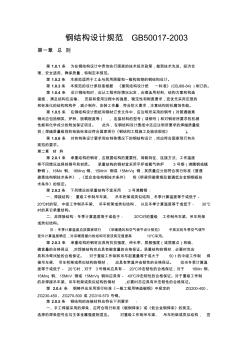钢结构设计规范
钢结构设计规范基本信息
| 书名 | 《钢结构设计规范》 | 作者 | 中国工程建设标准化协会组织 |
|---|---|---|---|
| 类别 | 图书 > 建筑 > 标准和规范图书 > 工具书 > 标准 | 页数 | 246 |
| 出版社 | 中国建筑工业出版社 | 出版时间 | 2006-09-01 |
| 装帧 | 平装 | 开本 | 16开 |
| 版次 | 1 | ||
General principles,Terms and symbols,Basic design stipulations,Calculation of flexural members,Calculation of axially loaded members and members subjected to combined axial load and bending
钢结构设计规范造价信息
1 General principles
2 Terms and symbols
2.1 Terms
2.2 Symbols
3 Basic design stipulations
3.1 Design principles
3.2 Load and calculation of load effects
3.3 Material selection
3.4 Design indices
3.5 Provisions for deformation of structures and structural members
4 Calculation of flexural members
4.1 Strength
4.2 Overall stability
4.3 Local stability
4.4 Calculation of built-up girder with webs taking accout of post-buckling strength
5 Calculation of axially loaded members and members subjected to combined axial load and bending
5.1 Axially loaded members
5.2 Members subjected to combined axial load and bending
5.3 Effective length andallowable slenderness ratio
5.4 Local stability of compression members
6 Fatigue calculation
6.1 General stipulations
6.2Fatigue calculation
7 Calculation of connections
7.1 Welded connection
7.2 Fastener connection
7.3 Flange connection of built-up I-section
7.4 Beam-to-column rigid connection
7.5 Calculation of connected plates at joints
7.6 Supports
8 Detailing requirements
8.1 General stipulations
8.2 Welded connection
8.3 Bolted riveted connections
8.4 Structural members
8.5 Requirements for crane girders and crane trusses
8.6 Large span roof structures
8.7 Requirements for preventing brittle fracture under low temperature
8.8 Fabrication, transportation and erection
8.9 Protection and heat insulation
9 Plastic design
9.1 General stipulations
9.2 Calculation of members
9.3 Allowable slenderness ratio and detailing requirements
10 Steel tubular tructures
10.1 General stipulations
10.2 Detailiing requirements
10.3 Capacity of members and joints
11 Composite steel and concrete beams
11.1 General stipulations
11.2 Design of compolite beams
11.3 Calculation of shear connectors
11.4 Calculation of deflection
11.5 Detailing requirements
Appendix A Allowable deflection of structures of structural members
Appendix B Overall stability factor of beams
Appendix C Stability factor of axial compression memebers
Appendix D Effective length factor for columns
Appendix E Classification of memebers and connections for fatigue calculation
Appendix F Stability calculation of truss gusset plate subject to compressive force of the diagonalweb member
Explanation of wording in this Code
《钢结构设计规范》是一个中华人民共和国国家标准。
《钢结构设计规范》(GB50017-2003中华人民共和国国家标准)》本规范内容包括:术语和符号、基本设计规定、受弯构件的计算、疲劳计算、构造要求、塑性设计、钢管结构、钢与混凝土组合梁等11部分。 2100433B
钢结构设计规范常见问题
-
已发
-
钢结构设计规范有:1、《钢结构设计规范》(GB50017-2003) ;2、《冷弯薄壁型钢结构设计规范(GBJ18-87)》; 3、《高层民用建筑钢结构技术规程(JGJ99-98)》 ;4、《门式刚架...
-
刚好有,希望对你有用。
钢结构设计规范文献

 《钢结构设计规范》回顾与展望
《钢结构设计规范》回顾与展望
我国的钢结构设计规范是随着建筑钢结构的应用逐步发展和完善的,经历了74规范TJ17—74、88规范GBJ17—88和03规范GB50017—2003。目前已基本完成对03规范的修订工作,即将颁布的规范下面称之为新规范。1 74规范74规范前,我们没有自己编制的钢结构设计规范,所以说,74规范是我国第一本正规的钢结构设计规范。新中国成立之前,我们没有自己的钢结构设计规范。

 钢结构设计规范 (2)
钢结构设计规范 (2)
钢结构设计规范 GB50017-2003 第一章 总 则 第 1.0.1 条 为在钢结构设计中贯彻执行国家的技术经济政策,做到技术先进、经济合 理、安全适用、确保质量,特制定本规范。 第 1.0.2 条 本规范适用于工业与民用房屋和一般构筑物的钢结构设计。 第 1.0.3 条 本规范的设计原则是根据 《建筑结构设计统 一标准》 (CBJ68-84))制订的。 第 1.0.4 条 设计钢结构时,应从工程实际情况出发,合理选用材料、结构方案和构造 措施,满足结构在运输、 安装和使用过程中的强度、稳定性和刚度要求,宜优先采用定型的 和标准化的结构和构件,减少制作、安装工作量,符合防火要求,注意结构的抗腐蚀性能。 第 1.0.5 条 在钢结构设计图纸和钢材订货文件中,应注明所采用的钢号(对普通碳素 钢尚应包括钢类、炉种、脱氧程度等) 、连接材料的型号(或钢号)和对钢材所要求的机械 性能和化学成分
《钢结构设计规范》GBJ17-88
本手册是《新编钢结构设计手册》、《钢结构数据速查手册》的配套用书,编写本手册的目的是为了让钢结构设计人员能够更全面地掌握GB50017-2003《钢结构设计规范》与修订前的GBJ17-1988的区别之处,从而为广大技术人员提供方便。 本手册共分上下两篇,上篇新旧钢结构设计规范对照主要介绍新旧规范的条文并详细讲解区别之处及修改的依据;下篇钢结构设计规范应用——设计实例则通过典型的习题来分析对比新旧钢结构设计规范的不同之处,通过实际的计算让广大技术人员更容易理解新旧钢结构设计规范在设计中的区别。 本手册内容全面实用,是从事钢结构设计、施工及质量验收工作的工程技术人员的必备参考书。2100433B
基本信息
作 者: 崔佳 编 萧正辉 译
版 次: 1
页 数: 346
装 帧: 平装
开 本: 16开
所属分类: 图书>建筑>标准和规范
内容简介
《钢结构设计规范理解与应用》介绍了《钢结构设计规范》GB50017-2003中对材料、计算方法以及构造要求等的理论和试验依据,力图帮助读者对新规范有比较系统、全面和清晰的理解。同时,还介绍了在实际工程中如何具体应用规范条文,以及在应用中应注意的一些问题。为适合广大工程技术人员阅读,《钢结构设计规范理解与应用》在公式推导和规范修订背景材料介绍中,较全面具体,但对繁琐的数学、力学问题未进行详细的叙述,只指明出处供读者查阅。全书共分十一章,除第一、二章外,其余各章的编排及章名与规范正文相一致,以便对照阅读。《钢结构设计规范理解与应用》可供建筑结构设计人员使用,也可供相关技术人员及高校师生学习、参考。
- 相关百科
- 相关知识
- 相关专栏
- 机制玻镁复合板风管制作与安装
- 聚氨酯硬泡保温复合板
- 轻质复合板组合房屋
- 菲亚特派力奥
- 不锈钢复合板
- 铝木复合板
- 三维中空复合板
- 发电太阳能热水器
- 金属泡沫复合板
- 建筑弱电
- 钛类复合板
- 铜钢复合板
- 建筑构造专项图集88JZ5 钢板石膏复合板隔墙
- ZC-FFF发泡水泥复合板
- APD
- 钛钢复合板
- 中博会展中心C1区钢结构屋面大型主桁架的施工技术
- 中国建筑抗震设计规范的演变与展望
- 中国水泥工厂余热发电设计规范国家标准即将出台
- 中国钢结构承包市场调查及未来五年投资前景评估报告
- 在建筑钢结构工程中美国标准设计的高强构件替代
- 原油和天然气输送管道穿跨越工程设计规范跨越工程.
- 优秀钢结构厂房施工组织设计方案(技术标)
- 中国钢结构协会钢管分会七届三次会员大会
- 中国一冶完成印度ESSAR高炉工程所有钢结构制作
- 中、美混凝土结构设计规范正截面受弯承载力计算对比
- 中电三十八所无线测试塔工程钢结构平台安装专项方案
- 改性聚磷酸铵在室内水性超薄型钢结构防火涂料中应用
- 关于发布国家标准水利水电工程节能设计规范公告
- 广东科学中心主楼幕墙工程A区主入口球钢结构工程制
- 关于900t铁路架桥机钢结构焊接工艺采用标准
- 关于发布铁路路基土工合成材料应用设计规范通知
